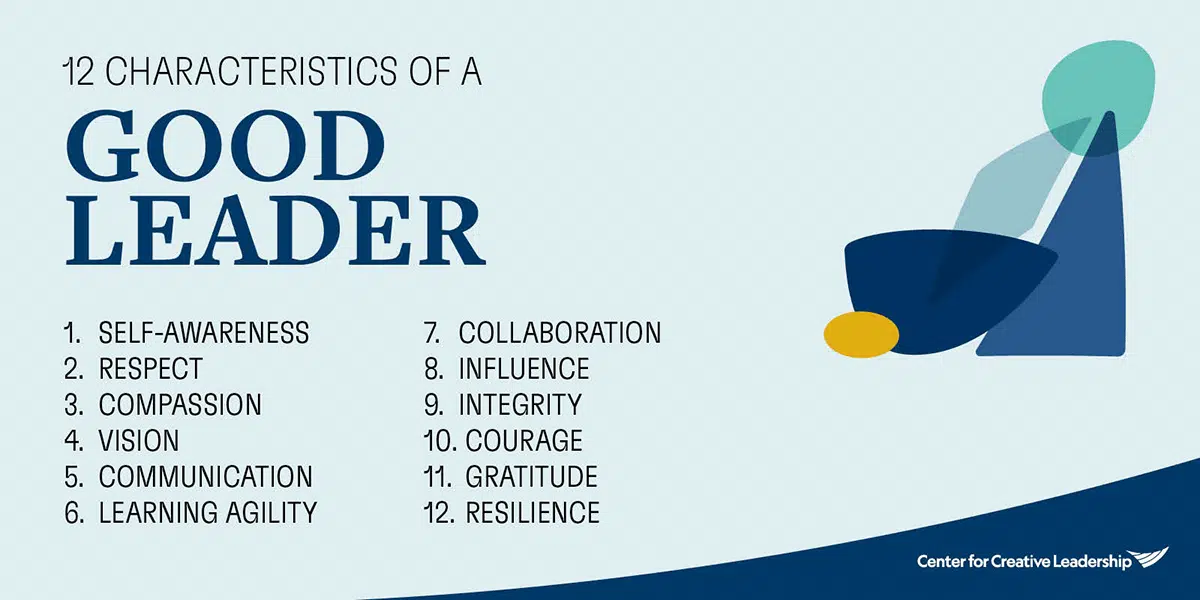Leaders shape our teams, organizations, communities, and world.
We need good leaders to help guide us and make the essential decisions, big and small, that keep things moving forward.
Our society is usually quick to identify a bad leader, but how can you identify a good one? What would most people say are the qualities of a good leader?
What Good Leadership Looks Like
Based upon our decades of research and experience working with leaders at thousands of organizations around the world, we’ve found that the best leaders consistently possess certain fundamental qualities and skills. Here are 12 essential leadership traits.
- Self-Awareness
- Respect
- Compassion
- Vision
- Communication
- Learning Agility
- Collaboration
- Influence
- Integrity
- Courage
- Gratitude
- Resilience
1. Self-Awareness
Self-awareness is the understanding of yourself, including personality traits, behaviors, anxieties, and emotions. While this is a more inwardly focused trait, self-awareness and humility are paramount qualities of leadership. The better you understand yourself and recognize your own strengths and weaknesses, the more effective you can be as a leader. Do you know how other people view you, and do you understand how you show up at work and at home? Take the time to learn about the 4 aspects of self-awareness and how to strengthen each component.
2. Respect
Respect, when demonstrated consistently, is one of the most important things a leader can do. It helps ease tensions and conflict, fosters trust, and improves your effectiveness. Creating a culture of respect is about more than just the absence of disrespect. Respectfulness can be shown in many different ways, but it often starts with showing you truly value others’ perspectives and making an effort to build belonging in the workplace — both critical components of healthy workplace cultures.
3. Compassion
Compassion is more than simply showing empathy or even listening and seeking to understand. Compassion requires leaders to act on what they learn. After someone shares a concern or speaks up about something, they won’t feel truly heard if their leader doesn’t then take some type of meaningful action on the information, our researchers have found. This is the core of compassionate leadership, and it helps to build trust, increase collaboration, and decrease turnover across organizations.
4. Vision
Vision is your aspiration for the future. Motivating others and garnering commitment toward that vision are essential parts of leadership. Purpose-driven leaders ensure they connect their team’s daily tasks and the values of individual team members to the overall direction of the organization. This can help employees find meaning in their work — which increases engagement, inspires trust, and drives priorities forward. You’ll want to communicate the vision in ways that help others understand it, remember it, and go on to share it themselves.
5. Communication
Communication shows up in many ways, from transmitting information and storytelling to soliciting input and using active listening techniques. The best leaders are skilled communicators who can communicate in a variety of ways, both orally and in writing, and with a wide range of people from different backgrounds, roles, levels, geographies, and more, because leadership and communication are intertwined. The quality and effectiveness of communication among leaders at your organization will directly affect the success of your business strategy, too.
6. Learning Agility
Learning agility is the ability to know what to do when you don’t know what to do. If you’re a “quick study” or are able to excel in unfamiliar circumstances, you might already be learning agile. But anybody can foster and increase learning agility through intentional practice and effort. After all, great leaders are really great learners.
7. Collaboration
Collaboration is a characteristic shown when leaders work effectively with a variety of colleagues of different social identities, locations, roles, and experiences. As the world has become more complex and interconnected, good leaders find themselves spanning boundaries and learning to work across various types of divides and organizational silos. When leaders value and embrace collaboration, whether within their teams or cross-functionally, several benefits arise — including increased innovation, higher-performing teams, and a more engaged and empowered workforce.
8. Influence
Influence, or being able to persuade people through thoughtful use of appropriate influencing tactics, is an important trait of inspiring, effective leaders. For some people, “influence” may sound unseemly. But as a leader, you must be able to influence others to get the work done — you cannot do it all alone. Influence is quite different from manipulation, and it needs to be done authentically and transparently. It requires high levels of emotional intelligence and trust.
9. Integrity
Integrity is being consistent, honest, moral, and trustworthy, and it’s an essential leadership trait for the individual and the organization. It’s especially important for top-level executives who are charting the organization’s course and making countless other significant decisions. Our research has found that leader integrity is a potential blind spot for organizations, so make sure you reinforce the importance of honesty and integrity to managers at all levels.
10. Courage
Courage enables both team members and leaders to take bold actions that move things in the right direction. It can be hard to speak up at work, whether you want to voice a new idea, provide feedback to a direct report, or flag a concern for someone above you. That’s part of the reason courage is a key leadership trait — it takes courage to do what’s right! Leaders who promote high levels of psychological safety in the workplace enable their teams to speak up freely and share candid concerns without fear of repercussions. This fosters a coaching culture that supports courage and truth-telling.
11. Gratitude
Gratitude is the uplifting emotion experienced after receiving something of value. Being thankful can lead to higher self-esteem, reduced depression and anxiety, and better sleep. Sincere gratitude can even make you a better leader. Yet few people regularly say “thank you” in work settings, even though most people say they’d be willing to work harder for an appreciative boss. The best leaders know how to show frequent gratitude in the workplace.
12. Resilience
Resilience is more than the ability to bounce back from obstacles and setbacks — it’s the ability to respond adaptively to challenges. Practicing resilient leadership means you’ll project a positive outlook that will help others maintain the emotional strength they need to commit to a shared vision, and the courage to move forward and overcome setbacks. A good leader focuses on resilience, both taking care of themselves and also prioritizing leading employee wellbeing, too — thereby enabling better performance for themselves and their teams.
Download a PDF action guide and summary of these characteristics of a good leader, so you always have a visual reminder available of these 12 qualities of good leadership.
3 Core Truths About the Traits of Good Leaders
At the Center for Creative Leadership (CCL)®, we’ve been researching the traits of a good leader and the role of leadership for nearly 6 decades. Here are 3 of our core tenets about good leaders and effective leadership.
Good leaders are made, not born.
First, we believe that leaders are made, not born. Put another way, leadership is a skill that can be developed. Good leaders are molded through experience, continued study, intentional effort, and adaptation. So you can strengthen any of these 12 characteristics of a good leader, if you’re open to growth, use your experiences to fuel development, and put in the time and effort toward self-improvement.
Similarly, organizations can help their people hone these top leadership qualities by providing ample opportunities for training, offering support for learning from challenges, and providing access to coaching and mentoring programs.
Leadership is a social process.
It’s also essential to recognize that leadership is less about one strong or charismatic individual, and more about a group of people working collectively to achieve results together. If you demonstrate several of the characteristics of a good leader, but fail to grasp this key point, chances are you won’t get very far on your own. You may be well-liked and respected, but it will be challenging to accomplish team or organizational goals. At CCL, we like to say that the outcomes of leadership are about creating direction, alignment, and commitment, or DAC, within a group.
Good leadership never stops.
Also, we believe that leadership isn’t a destination, it’s a journey — it’s something that you’ll have to work at regularly throughout your career, regardless of what level you reach in your organization or what industry you work in. Different teams, projects, and situations will provide different challenges and require different leadership qualities and competencies to succeed. So you will need to be able to continue to apply these leadership characteristics in different ways throughout your career. Just continually keep learning and growing, and you’ll be an agile learner with a long career.
How to Develop and Nurture the Qualities of a Good Leader
Organizations can strengthen leadership qualities and foster deeper levels of engagement at work through providing a variety of on-the-job learning experiences, mentoring, and formal development opportunities. At CCL, we have many award-winning leadership solutions with clients around the world, and we’d be honored to work with you and your organization as well.
But individuals don’t have to wait to begin strengthening these leadership characteristics within themselves. If you decide you want to work proactively on developing your leadership qualities and skills, download our action guide & visual summary of this content. And get our tips on how to convince your boss to make an investment in you and your future. We’re here to support you every step of the way on your journey to becoming a better leader!
Ready to Take the Next Step?
After you download the 12 Characteristics of a Good Leader, keep on learning and growing: never miss our exclusive leadership insights and tips — subscribe to our newsletters to get our research-based articles, webinars, resources, and guides delivered straight to your inbox.
Keep these qualities of a good leader top of mind in the future: download a PDF summary of this article as an action guide and visual reminder of the leadership qualities to nurture in yourself, on your team, and at your organization in the future.












